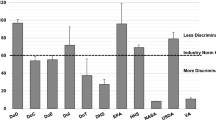Abstract
Improved efforts to transfer the results of Federally-sponsored R&D to industry are cited often as an approach to help reverse declines in the rate of growth of U.S. industrial productivity and in the international competitiveness of certain industry sectors. As taxpayers and policy makers intensify their demands for accountability of public expenditures, technology transfer advocates must develop and apply analytic approaches which will measure the significant short and long-range impacts of Federally-sponsored programs, even though these impacts are especially difficult to measure directly.
This paper suggests a framework for evaluating Federal technology transfer in terms of short and long range goals and outputs. It outlines critical determinants of program success and suggests performance indicators through which results could be measured.
Similar content being viewed by others
References
Comroe, J. H., Jr. and Dripps, R. D., “Scientific Basis for the Support of Biomedical Science”,Science, 192, 1976, 105–111.
Comroe, J. H., Jr., “The Road from Research to New Diagnosis and Therapy”,Science, 200, 1978, 931–937.
Cushen, W. Edward, and Chafer, Sallie Birket,Design Parameters for a Federal Laboratories Program, February 1977, Report to the National Science Foundation (NSF-7080-EC-SC-76-FR-2).
Denison, Edward F.,Accounting for United States Economic Growth, 1929–1969, 1974, Brookings Institution, Washington, D.C.
Early, Eugene H., “Measuring the Effectiveness of a Rapid Response Technology Transfer Program”, J. A. Jolly and J. W. Creighton (eds.),Technology Transfer in Research and Development, December 1975, Naval Postgraduate School and Naval Material Command, Washington, D.C. pp. 61–80.
Evaluation and Analysis to Support Decision Making, December 1975, United States General Accounting Office (PAD-76-9), Washington, D.C.
Finding Out How Programs are Working; Suggestions for Congressional Oversight. November 1977, United States General Accounting Office (PAD-78-3), Washington, D.C.
Lesher, Richard L. and Howick, George J.,Assessing Technology Transfer. 1966, National Aeronautics and Space Administration (NASA SP-5067), Washington, D.C. pp. 88–101.
Mansfield, Edwin, “Contribution of R&D to Economic Growth in the United States”,Science, 175, 1972, 477–486.
Mansfield, Edwin, “Research and Development, Productivity and Inflation”,Science, 209, 1980, 1091–1093.
Message from the President of the United States Concerning Science and Technology to the Congress of the United States, March 16, 1972.
Research and Innovation: Developing a Dynamic Economy, December 1980, Joint Economic Committee, Congress of the United States, Washington, D.C.
Roessner, J. David,Federal Technology Transfer — An Analysis of Current Program Characteristics and Practices, A Report Prepared for the Committee on Domestic Technology Transfer Federal Council for Science and Technology, December 1975, National Science Foundation (NSF-76-400), pp.5–7;
Ibid., pp.21–24.
Roessner, J. David. “Technological Diffusion Research and National Policy Issues”,Knowledge, 2, 1980, 179–201.
Science Indicators 1978, Report of the National Science Board (NSB-79-1).
Status and Issues: Federal Program Evaluation, October 1978, United States General Accounting Office (PAD-78-83), Washington, D.C.
Stewart, Charles T., Jr., “A Summary of the State-of-theArt on the Relationship Between R&D and Economic Growth/Productivity” InColloquia on U.S. Research and Development and Economic Growth Productivity, 1972, National Science Foundation, (NSF-72-303).
Technology and Trade: Some Indicators of the State of U.S. Industrial Innovation, April 21, 1980, Report for the Subcommittee on Trade of the Committee on Ways and Means, U.S. House of Representatives (WMCP: 96-46).
Technology Transfer Utilization: Recommendations for Redirecting the Emphasis and Correcting the Imbalance, 1974, National Academy of Engineering, Washington, D.C., pp.6–9.
Ibid. pp.11–29.
Teich, Albert H., Statement before the Subcommittee on Science, Research and Technology, U.S. House of Representatives, Hearings on the Role of Federal Laboratories in Transferring Technology to State and Local Governments, June 12, 1979.
The President's Industrial Innovation Initiatives, “Fact Sheet”, October 31, 1979.
Tewksbury, J. G., Crandall, M. S., and Crane, W. E., “Measuring the Societal Benefits of Innovation”,Science, 209, 1980, 658–662.
Author information
Authors and Affiliations
Rights and permissions
About this article
Cite this article
O'Brien, T.C., Franks, L.M. Evaluation framework for Federal technology transfer initiatives. J Technol Transfer 6, 73–86 (1981). https://doi.org/10.1007/BF02173261
Issue Date:
DOI: https://doi.org/10.1007/BF02173261




